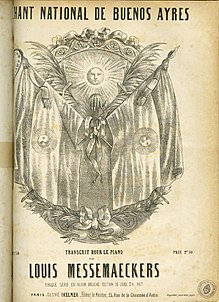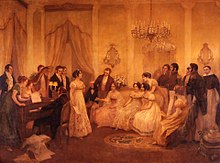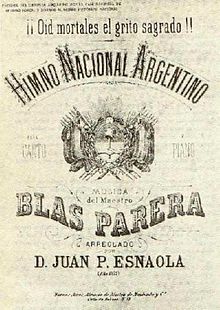Argentine National Anthem
| English: Argentine National Anthem | |
|---|---|
 French transcription for piano by Luis Messemaeckers, published in 1822. This is the oldest sheet music found of the Argentine national anthem outside of Argentina. | |
National anthem of | |
| Also known as | "Oíd, mortales, el grito sagrado: ¡Libertad! ¡Libertad! ¡Libertad!" (English: Hear, mortals, the sacred cry: Freedom! Freedom! Freedom!) |
| Lyrics | Vicente López y Planes, 1812 |
| Music | Blas Parera, 1813 |
| Adopted | 11 May 1813 |
| Audio sample | |
U.S. Navy Band instrumental version | |
The "Argentine National Anthem" (Himno Nacional Argentino) was adopted as the sole official song of Argentina on 11 May 1813—three years after the May Revolution. Its lyrics were written by the Buenos Aires-born politician Vicente López y Planes and the music was composed by the Spanish musician Blas Parera.[1]
Some first, quite different, anthems were composed from 1810; a version was then introduced in 1813, which was used throughout the 19th century. What is now officially codified as the state's national anthem is shorter than the original composition and comprises only the first and last verses and the chorus of the 1813 "Patriotic March", omitting much emotional text about the struggle for independence from Spain ("with strong arms they tear to pieces the arrogant Iberian lion").
11 May is celebrated in Argentina as the Argentine National Anthem Day (Día del Himno Nacional Argentino).[2]
Etymology
[edit]The third Argentine national anthem was originally named "Marcha Patriótica" (English: Patriotic March), later renamed "Canción Patriótica Nacional" (English: "National Patriotic Song"), and then "Canción Patriótica" (English: "Patriotic Song"). It has been called "Himno Nacional Argentino" since it was published with that name in 1847.
History
[edit]
The first Argentine national anthem was the "Patriotic March", published on 15 November 1810 in the Gazeta de Buenos Ayres. It had lyrics by Esteban de Luca and music by Blas Parera. This original composition made no reference to the name of Argentina (the country was not formally named "República Argentina" until 1826, although it was referred to as such) or an independentist will, and talked instead about Spain being conquered by France in the Peninsular War, the absolutist restoration begun by the Council of Regency, and the need to keep the republican freedoms achieved so far in the Americas: "Spain was victim / of the plotting Gaul / because to the tyrants / she bent her neck / If there treachery / has doomed a thousands cities / let sacred freedom and union reign here / Let the father to the sons / be able to say / enjoy rights / that I did not enjoy".[3]
In mid-1812, the ruling triumvirate ordered the Buenos Aires Cabildo to commission a national anthem. Cayetano Rodríguez, a Franciscan friar, wrote a text that was approved on 4 August. The Catalan musician Blas Parera, music director of the local theater, set it to music and performed it for the first time with the orchestra he conducted on 1 November.[4]
Less than a year later the Assembly of Year XIII estimated that the song was not effective enough to serve as a national anthem. On 6 March 1813 several poets were asked to submit lyrics. The poem by the lawyer Vicente López y Planes was unanimously considered the best. It was approved as the "sole national march" ("única marcha nacional") on 11 May 1813. Parera was asked to compose a new musical setting around the same date. He must have finished the piece in a few days. Oral tradition has it that the premiere took place on 14 May 1813, at the home of the aristocrat Mariquita Sánchez de Thompson, but there is no documentary evidence of that.[5] If this is true, then Parera, contrary to certain misconceptions, wrote quickly and under no visible coercion. The published song sheet is dated 14 May 1813. He again conducted the official premiere in the theater on 28 May, and was paid 200 pesos.[6]

The composition was then known as Canción Patriótica Nacional (National Patriotic Song), and later simply as Canción Patriótica (Patriotic Song), but in Juan Pedro Esnaola's early arrangement, dated around 1848, it appeared under the title Himno Nacional Argentino, and the name has been retained until today.[7] In the complete version of the Anthem of May (as was christened by López) it is noted that the political vision portrayed is not only Argentine, but Latin American. The lyrics are ardently pro-independence and anti-Spanish, as the country was at that time fighting for its independence from Spain.[8]
The song became popular immediately. Within ten years documented performances took place throughout Argentina, and also in Chile, Peru, and Colombia until they had their own national anthems.[9] Different versions emerged, making mass singing difficult; several reforms were then proposed. In 1860 Esnaola was commissioned to create an official version. He took the task to heart, making many changes to the music, including a slower tempo, a fuller texture, alterations to the melody, and enrichment of the harmony. In 1927 a committee produced a historicist version that undid several of Esnaola's changes, but introduced new problems in the sung line. After a heated public debate fueled by the newspaper La Prensa, this version was rejected and, following the recommendations of a second committee, Esnaola's arrangement was officially reinstated.[10] In 1944 it was confirmed as the official state anthem.
Throughout the 19th century the anthem was sung in its entirety. However, once harsh feelings against Spain had dissipated, and the country had become home to many Spanish immigrants, a modification was introduced by a decree of President Julio Argentino Roca on 30 March 1900:
"Without producing alterations in the lyrics of the National Anthem, there are in it verses that perfectly describe the concept that nations universally have regarding their anthems in peaceful times, and that harmonize with the serenity and dignity of thousands of Spanish that share our living, those that can and must be preferred to be sung in official parties, for they respect the traditions and the law in no offense to anyone, the President of the Republic decrees that: In official or public parties, as well as in public schools, shall be sung only the first and last verses and the chorus of the National Song sanctioned by the General Assembly on May 11, 1813."
Controversy
[edit]The song includes a line that has given rise to controversy: Buenos--Ayres se [o]pone á la frente De los pueblos de la ínclita union. In the manuscript and an early printed song-sheet the word opone is used; a slightly later version of the song-sheet correcting obvious errors such as spelling mistakes was issued with the same date of 14 May 1813, but with opone changed to pone. The meaning reverses: "Buenos Aires opposes the front of the people of the union" to "Buenos Aires positions itself at the front ...". The original opone has been interpreted as advancing part of the centralist views in Buenos Aires, but has also been considered a "tragical misprint".[11] In many other lines the anthem goes beyond the Argentine theater of the Spanish American wars of independence and references events in Mexico, Central America, Northern South America, and Upper Peru.[12] The growing ideas of independence are reflected in lines such as "On the surface of the earth rises a glorious new nation, her head is crowned with laurels, and a Lion lies defeated at her feet". This portrays not just Spanish absolutism, but Spain itself, as the enemy.[13]
The words strongly attacking Spain were no longer sung.[14]
Usage
[edit]Performance of the national anthem is mandatory during all official events, and Argentines in attendance are expected to stand up and sing it. Radio broadcasters voluntarily perform the anthem at midnight, while TV channels do so before closing down their daily broadcast. On national holidays, it is mandatory to perform the national anthem at midnight.
The national anthem is ruled in Argentine law by Decree 10302/1944.[15]
The rock musician Charly García broke legal regulations dealing with the reproduction of the song when he included an idiosyncratic cover version in his 1990 album Filosofía barata y zapatos de goma, stirring much controversy.[16] In 1998 various Argentine artists reedited the anthem and other patriotic songs in the joint album El Grito Sagrado. Other singers followed on their footsteps recreating the piece in their own ways.
A line from the original version of the national anthem was used as the Argentine title of the 1928 film known in English as The Charge of the Gauchos.
The national anthem appears at the beginning of the 1985 film The Official Story, an Academy Award winner.
Short instrumental versions
[edit]Due to the excessive length of the official full-length version, which has a duration of around three to four minutes, during international sporting events such as professional soccer games, the Rugby World Cup, and the Olympics, only the instrumental introduction (which has a duration of around 1 minute) is played. Another variation is to play the instrumental introductory section followed by the last three lines (with the third line repeated). Since 2019, in professional soccer games, the final part of the anthem is played, which consists of the instrumental part before the chorus, the chorus, and the coda.[17] The Olympic Games currently uses an abridged version of the anthem which consists of the entire modern version's lyrics, with the pre-chorus instrumental omitted. Although traditional, these arrangements are not recognized by Argentine law.
Lyrics
[edit]Modern version
[edit]The following is the modern version, adopted in 1924, omitting the long anti-Spanish middle section.
| Spanish original[18] | English translation |
|---|---|
Oíd, mortales, el grito sagrado: |
Hear, mortals, the sacred cry: |
Full lyrics
[edit]| Spanish original[19][20] | English translation |
|---|---|
I |
I |
References
[edit]- ^ "Símbolos Nacionales" [National Symbols] (in Spanish). Presidency of the Argentine Nation. Retrieved 21 November 2011.
La necesidad de tener una canción patriótica, que surgió con la Revolución de Mayo y que el Triunvirato supo comprender, se ve plasmada hoy en el Himno Nacional Argentino, con música de Blas Parera, letra de Vicente López y Planes, y arreglo de Juan P. Esnaola.
- ^ "Día del Himno Nacional Argentino". Argentina.gob.ar. 11 May 2019.
- ^ Galasso, Norberto (2000). Seamos libres y lo demás no importa nada [Let us be free and nothing else matters] (in Spanish). Buenos Aires: Colihue. p. 103. ISBN 978-950-581-779-5.
España fue presa / del Galo sutil / porque a los tiranos / rindió la cerbiz. / Si allá la perfidia / perdió a pueblos mil / libertad sagrada / y unión reine aquí / El padre a sus hijos / pueda ya decir / Gozad de derechos / que no conocí.
- ^ Vega, Carlos (1962). El Himno Nacional Argentino [The Argentine National Anthem] (in Spanish). Buenos Aires: Eudeba. pp. 15–18.
- ^ Galasso, p. 102.
- ^ Vega, El Himno Nacional Argentino, pp. 22–27.
- ^ Vega, El Himno Nacional Argentino, pp. 88–89.
- ^ "Argentina". NationalAnthems.me. Archived from the original on 13 April 2018. Retrieved 21 November 2011.
The original lyrics of the anthem included harsh attacks on Spain, the former colonial power.
- ^ Vega, El Himno Nacional Argentino, pp. 30–41.
- ^ Buch, Esteban (January 1994). O juremos con gloria morir: historia de una épica de estado [Or swear to die gloriously: history of a state epic] (in Spanish). Buenos Aires: Editorial Sudamericana. pp. 103–114. ISBN 978-950-07-0964-4.
- ^ The Patriotic March written by Vicente López: Depiction of a historical scene of tension. Analysis of the original Marcha Patriótica, in Spanish, with abstract in English.
- ^ Galasso, pp. 102–103.
- ^ Galasso, p. 103.
- ^ Buch, O juremos con gloria morir, pp. 87–92.
- ^ "Decreto 10302/1944" [Decree 10302/1944] (in Spanish). Ministry of Justice and Human Rights. Retrieved 21 November 2011.
- ^ Buch, O juremos con gloria morir, pp. 147–156.
- ^ "The Argentina national team sang the anthem on all television channels a few hours before the final against France". 18 December 2022.
- ^ "Himno Nacional". Embassy in Japan. Retrieved 13 April 2022.
- ^ "Símbolos Nacionales". Argentina.gob.ar (in Spanish). 26 October 2017. Retrieved 13 April 2022.
- ^ Sousa, John Philip (1890). National, Patriotic and Typical Airs of All Lands: With Copious Notes. H. Coleman. p. 31.
Notes
[edit]External links
[edit]- Argentina: Himno Nacional Argentino - Audio of the national anthem of Argentina, with information and lyrics (archive link)
- Argentine National Anthem MP3
- Argentine National Anthem (vocal) MP3
- Argentine National Anthem MP3
- Argentine National Anthem with English subtitles on YouTube.
- Listen in the Quechua language
- Argentine National Anthem (radio)


